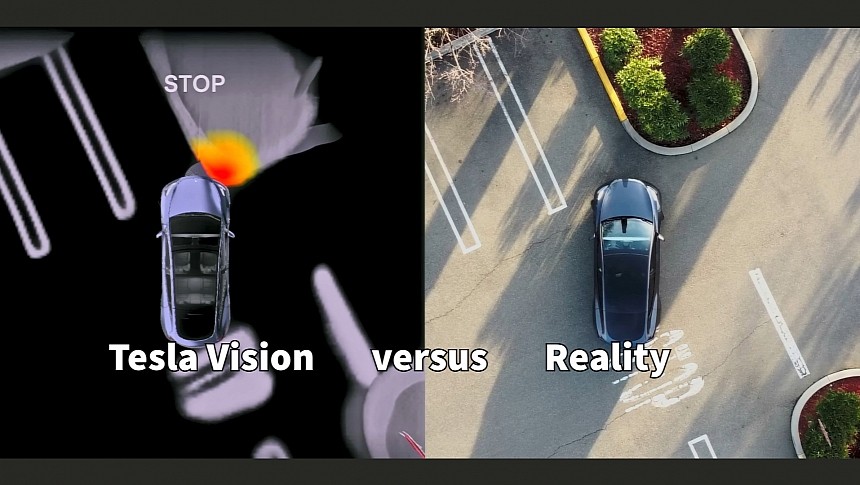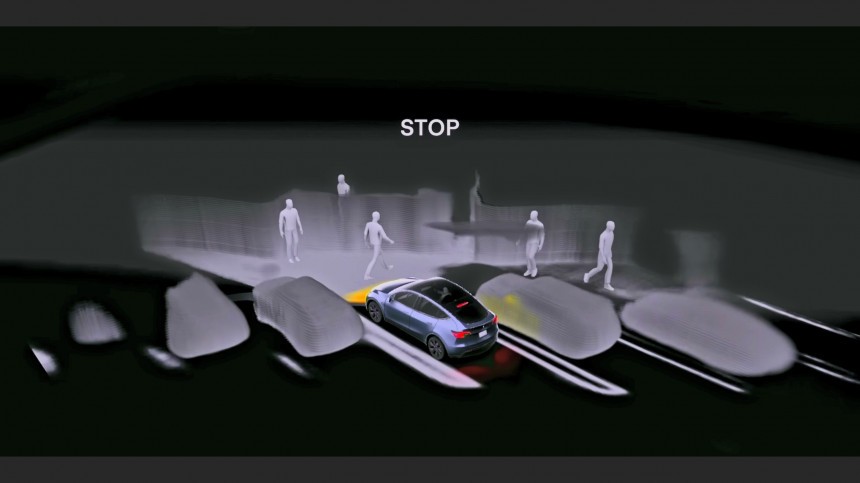Tesla removed the ultrasonic sensors from its vehicles, denying its users a basic functionality that every other car has. However, it recently launched High Fidelity Park Assist, which many claim is even better. Here's a video showing how accurate the new park assist system is in real life.
Over the years, Tesla has shown that it understands what its customers want. Software updates are the highlight of owning a Tesla, as is the Supercharger experience. However, Tesla also made questionable decisions that rattled even its most ardent fans. Many of these decisions resulted from Elon Musk's idea that cars don't need anything besides video cameras to "see" around. After all, humans only use their eyes to see where they are going, and they only have two instead of eight cameras in a Tesla EV.
Tesla removed the radar sensors in 2021, leaving some driver assistance systems crippled for a while. Tesla Vision eventually caught up and offered similar functionality. Even though a radar sensor returned on the Hardware-4 Model S/X, it is not actively used and is, for now, dormant. Moreover, newer vehicles, like the Model 3 Highland and Cybertruck, don't have a radar sensor. This means Tesla might have given up on using a radar after all.
This success made Tesla consider new things it could remove from its vehicles. Sure enough, in October 2022, the ultrasonic sensors were gone, and along with them, Tesla EVs lost Autopark, Park Assist, and Summon Functions. This put them at a disadvantage even compared with the cheapest cars on the market, all featuring ultrasonic sensors at least in the rear. Although the EV maker later offered distance measurement and Park Assist via Tesla Vision on vehicles without ultrasonic sensors (USS), this was a hit-and-miss feature, causing many owners to scratch their cars in stupid incidents.
However, things changed with the arrival of the High Fidelity Park assistant in December 2023. While many thought it was a gimmick packed inside the 2023 Holiday Update, the new feature became the most important software feature Tesla offered in years. The system is available on non-USS cars with Autopark (part of Enhanced Autopilot and FSD Beta), and it creates a 3D model of your surroundings while parking.
People who used it claim this is even better than the 360-degree bird's eye view owners desperately wanted. As Ashok Eluswami, Tesla's Autopilot Director, explained, the goal was that a driver could perform the complete parking maneuver just by looking at the infotainment screen. This is what Tesla is selling, but how good is the High Fidelity Park Assist in real life? A video shared online by AI DRIVR offers a new perspective comparing the images generated by Tesla Vision with the ones recorded by a drone camera from above.
As we've seen in previous videos, the High Fidelity Park Assist accurately represents the surroundings, including the markings on the ground. The image can be rotated at will, providing new angles to understand better what's around. The system proves invaluable during parking maneuvers, enabling unprecedented precision. It's not perfect, but it's already better than 360-degree cameras on other cars.
For once, it's obvious that the system is better at backing into places, undoubtedly because the Tesla EVs, with the exception of the Cybertruck, lack a front bumper camera. The rear camera makes all the difference when going in reverse. This is also the recommended way of parking a vehicle, as it allows a safer departure from the parking space.
Another observation is that the High Fidelity Parking Assist seems to lose accuracy the closer the car is to objects. That's because they are likely not in the camera's view at that point and are rendered from memory instead. Watch the video below and tell us your thoughts in the Comments section.
Tesla removed the radar sensors in 2021, leaving some driver assistance systems crippled for a while. Tesla Vision eventually caught up and offered similar functionality. Even though a radar sensor returned on the Hardware-4 Model S/X, it is not actively used and is, for now, dormant. Moreover, newer vehicles, like the Model 3 Highland and Cybertruck, don't have a radar sensor. This means Tesla might have given up on using a radar after all.
This success made Tesla consider new things it could remove from its vehicles. Sure enough, in October 2022, the ultrasonic sensors were gone, and along with them, Tesla EVs lost Autopark, Park Assist, and Summon Functions. This put them at a disadvantage even compared with the cheapest cars on the market, all featuring ultrasonic sensors at least in the rear. Although the EV maker later offered distance measurement and Park Assist via Tesla Vision on vehicles without ultrasonic sensors (USS), this was a hit-and-miss feature, causing many owners to scratch their cars in stupid incidents.
However, things changed with the arrival of the High Fidelity Park assistant in December 2023. While many thought it was a gimmick packed inside the 2023 Holiday Update, the new feature became the most important software feature Tesla offered in years. The system is available on non-USS cars with Autopark (part of Enhanced Autopilot and FSD Beta), and it creates a 3D model of your surroundings while parking.
As we've seen in previous videos, the High Fidelity Park Assist accurately represents the surroundings, including the markings on the ground. The image can be rotated at will, providing new angles to understand better what's around. The system proves invaluable during parking maneuvers, enabling unprecedented precision. It's not perfect, but it's already better than 360-degree cameras on other cars.
For once, it's obvious that the system is better at backing into places, undoubtedly because the Tesla EVs, with the exception of the Cybertruck, lack a front bumper camera. The rear camera makes all the difference when going in reverse. This is also the recommended way of parking a vehicle, as it allows a safer departure from the parking space.
Another observation is that the High Fidelity Parking Assist seems to lose accuracy the closer the car is to objects. That's because they are likely not in the camera's view at that point and are rendered from memory instead. Watch the video below and tell us your thoughts in the Comments section.














